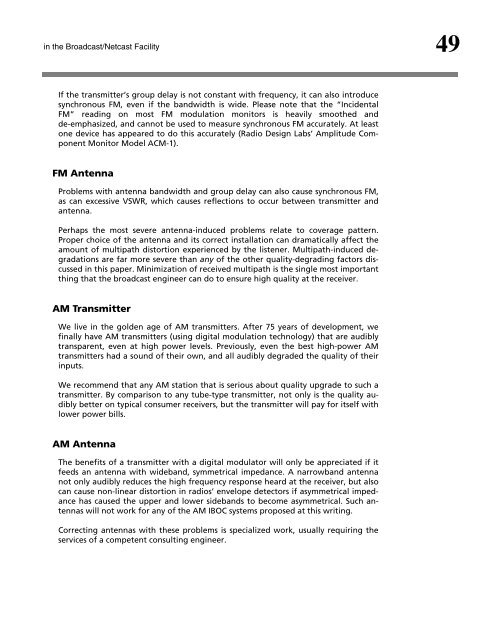Maintaining Audio Quality in the Broadcast Facility 2011 - Orban
Maintaining Audio Quality in the Broadcast Facility 2011 - Orban
Maintaining Audio Quality in the Broadcast Facility 2011 - Orban
You also want an ePaper? Increase the reach of your titles
YUMPU automatically turns print PDFs into web optimized ePapers that Google loves.
<strong>in</strong> <strong>the</strong> <strong>Broadcast</strong>/Netcast <strong>Facility</strong> 49<br />
If <strong>the</strong> transmitter’s group delay is not constant with frequency, it can also <strong>in</strong>troduce<br />
synchronous FM, even if <strong>the</strong> bandwidth is wide. Please note that <strong>the</strong> “Incidental<br />
FM” read<strong>in</strong>g on most FM modulation monitors is heavily smoo<strong>the</strong>d and<br />
de-emphasized, and cannot be used to measure synchronous FM accurately. At least<br />
one device has appeared to do this accurately (Radio Design Labs’ Amplitude Component<br />
Monitor Model ACM-1).<br />
FM Antenna<br />
Problems with antenna bandwidth and group delay can also cause synchronous FM,<br />
as can excessive VSWR, which causes reflections to occur between transmitter and<br />
antenna.<br />
Perhaps <strong>the</strong> most severe antenna-<strong>in</strong>duced problems relate to coverage pattern.<br />
Proper choice of <strong>the</strong> antenna and its correct <strong>in</strong>stallation can dramatically affect <strong>the</strong><br />
amount of multipath distortion experienced by <strong>the</strong> listener. Multipath-<strong>in</strong>duced degradations<br />
are far more severe than any of <strong>the</strong> o<strong>the</strong>r quality-degrad<strong>in</strong>g factors discussed<br />
<strong>in</strong> this paper. M<strong>in</strong>imization of received multipath is <strong>the</strong> s<strong>in</strong>gle most important<br />
th<strong>in</strong>g that <strong>the</strong> broadcast eng<strong>in</strong>eer can do to ensure high quality at <strong>the</strong> receiver.<br />
AM Transmitter<br />
We live <strong>in</strong> <strong>the</strong> golden age of AM transmitters. After 75 years of development, we<br />
f<strong>in</strong>ally have AM transmitters (us<strong>in</strong>g digital modulation technology) that are audibly<br />
transparent, even at high power levels. Previously, even <strong>the</strong> best high-power AM<br />
transmitters had a sound of <strong>the</strong>ir own, and all audibly degraded <strong>the</strong> quality of <strong>the</strong>ir<br />
<strong>in</strong>puts.<br />
We recommend that any AM station that is serious about quality upgrade to such a<br />
transmitter. By comparison to any tube-type transmitter, not only is <strong>the</strong> quality audibly<br />
better on typical consumer receivers, but <strong>the</strong> transmitter will pay for itself with<br />
lower power bills.<br />
AM Antenna<br />
The benefits of a transmitter with a digital modulator will only be appreciated if it<br />
feeds an antenna with wideband, symmetrical impedance. A narrowband antenna<br />
not only audibly reduces <strong>the</strong> high frequency response heard at <strong>the</strong> receiver, but also<br />
can cause non-l<strong>in</strong>ear distortion <strong>in</strong> radios’ envelope detectors if asymmetrical impedance<br />
has caused <strong>the</strong> upper and lower sidebands to become asymmetrical. Such antennas<br />
will not work for any of <strong>the</strong> AM IBOC systems proposed at this writ<strong>in</strong>g.<br />
Correct<strong>in</strong>g antennas with <strong>the</strong>se problems is specialized work, usually requir<strong>in</strong>g <strong>the</strong><br />
services of a competent consult<strong>in</strong>g eng<strong>in</strong>eer.



![[PDF] Using the ITU BS.1770-2 and CBS Loudness Meters ... - Orban](https://img.yumpu.com/50629372/1/190x245/pdf-using-the-itu-bs1770-2-and-cbs-loudness-meters-orban.jpg?quality=85)






![[PDF] Optimod-FM Feature Comparison - Orban](https://img.yumpu.com/41741615/1/190x245/pdf-optimod-fm-feature-comparison-orban.jpg?quality=85)






